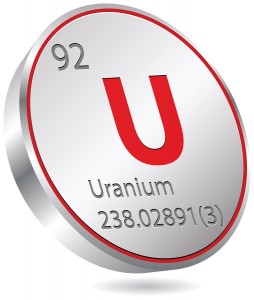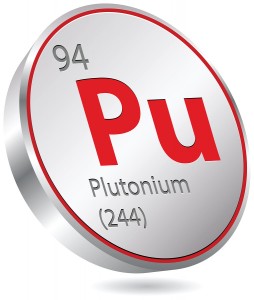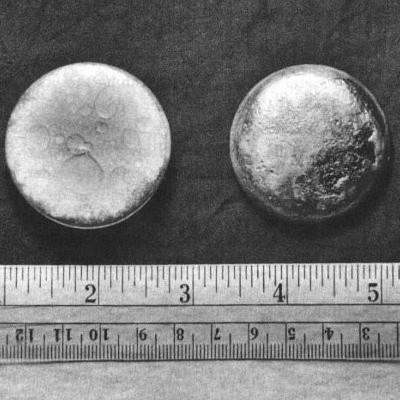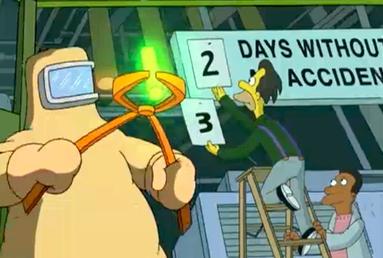Furthering our exploration of different energy sources that are alternatives to fossil fuels, let’s take a closer look at the energy source that was introduced in the last post, nuclear energy. In that post, I introduced where nuclear energy comes from (the nucleus of the atom), and that there are two types of reactions: fusion, and fission. After that, we learned that the heat and light from a nuclear reaction can be used directly as a heat source, or to create high-pressure steam that can then turn a turbine to create mechanical energy, or if connected to a electrical generator, electricity. This is very similar to the use of fossil fuels; the source of heat is just nuclear, not chemical.
This time, we’ll learn a bit more about exactly which types of atoms/nuclei are used as fission fuels. Not just any ol’ nucleus will do. Theoretically, in the right circumstances, any nuclei can react. Practically speaking, however, there are only a few options that really make sense for potent energy production here on Earth. So much learning!
Types of Fuels for Fission
Before I get into the specific fuels for fission, let’s go over a few things to make the explanations easier to understand. Fission requires a nucleus that is fissile, which means that if it absorbs a neutron, it becomes unstable, splits, and releases energy and more neutrons to react with other nuclei. Not every nucleus has this property. Within a particular element (defined as the amount of protons in the nucleus), there are different isotopes, which means that the nucleus has differing amounts of neutrons for a given amount of protons. Some of these isotopes of the same element can be fissile, while others are not. That’s the just the somewhat complicated nature of nuclear physics.
If a nucleus is not fissile, it might be fertile. This means that if we fire a neutron at it, it will absorb it, and then undergo a type of nuclear decay called beta decay which then turns that nucleus into a different fissile nucleus. Then we simply fire another neutron at it, and presto, fission. In this process, we are breeding a fissile fuel out of a fertile one, and the reactors that employ this process are called breeders.
Additionally, some nuclei are stable meaning they won’t spontaneously emit radiation (through radioactive decay), while others are unstable (or radioactive) and slowly radiate mass and energy, turning into different nuclei in the process. Radioactivity is separate from human-induced fission (ie: it occurs naturally).
Different isotopes are defined by the total number of protons and neutrons, called the mass number. So, a carbon atom (six protons) with six neutrons has a total mass of twelve (six + six). We would call this carbon-12. If it had seven neutrons, we would call it carbon-13 (six + seven). We could also simply use the symbol for carbon, C, followed by it’s mass number (e.g. C-12, C-13).
Now let’s look at the fission fuels we have available here on Earth:
Uranium
This is the classic. Uranium is the main fuel in every reactor that is currently in use worldwide (as of the writing of this post). Here’s its entry in the periodic table:

Uranium exists in nature as a blend of isotopes. There is no completely stable isotope of uranium, meaning they all undergo radioactive decay. For the naturally occurring isotopes of uranium, however, they are just barely radioactive and the decay process is extremely slow and on the order of billions of years. Thus, even though Earth is ~4.5 billion years old, there’s still quite a bit of it left, notably in Kazakhstan, Australia, and Canada. It is mined in ore form, known as uraninite, aka pitchblende, which looks like this:

Uranium found in nature is 99.3% uranium-238 (U-238) and 0.7% uranium-235 (U-235), with just a tiny smattering of U-234. For fission purposes, U-235 (at 0.7%) is the fissile isotope, while U-238 is fertile (more on that below). This means that literally 99.3% of the uranium out in nature is not the fissile type. Some nuclear reactor designs require that the uranium fuel be enriched meaning that the concentration of U-235 is increased to 2-5%. When uranium is enriched to 90% fissile (U-235) it is considered weapons-grade uranium, which makes this process a concern for nuclear weapons proliferation. Other nuclear reactor types, notably Canada’s CANDU unit, can operate on the natural 0.7% U-235 concentrations. At whatever level of enrichment, uranium fuel is processed into fuel pellets, that look like this:

All that unused uranium-238! Well, it’s useful as a really heavy metal, and maybe (hint, hint) there’s something else we can do with it. On to the next fuel!
Plutonium:
Plutonium is the stuff that the “Libyans” were getting from Doc Brown in Back to the Future, and for good reason; it’s potent stuff! Here’s its entry in the periodic table:

Plutonium barely exists in nature. There is one isotope, Pu-244 that is found in trace quantities, but otherwise we don’t have much of it here on Earth. Pu-239 and Pu-241 are fissile, but there isn’t enough in mineable concentrations, so how do we use it as a fuel?
Here’s the kicker: remember all that unused U-238? Well, it turns out that when U-238 absorbs a neutron, it sets off two beta decays which turn it into Pu-239! We can breed fissile plutonium from the most common uranium isotope. This happens to a certain degree in all uranium reactors as the fuel is used up, so we get this secondary reaction of using Pu-239 bred from the U-238.
That’s great, but it also means that the waste from uranium reactors contains leftover fissile plutonium, which can be used to create a weapon. A not-so-cool byproduct of the whole shebang. Here’s what plutonium looks like when its purified and in elemental form:

If only there was an abundant fuel for fission that didn’t produce scary wastes… On to the next one:
Thorium
Thorium, name after the Norse god Thor, is another heavy metal that exists in Earth’s crust at a decent concentration that is estimated to be 3-4 times the concentration of uranium. Here’s where it is on the periodic table:

All isotopes of thorium are unstable and thus radioactive. One particular isotope, Th-232, is the most stable and lasts for billions of years before noticeable decay, while the other isotopes don’t last nearly so long. Due to this relative stability, nearly all the thorium found in Earth’s crust is Th-232. It comes from a mineral known as monazite that looks like this:

And as luck would have it, Th-232 is fertile! So, we fire neutrons at it, and then it decays into first proactinium, and then a fissile isotope of uranium, U-233! This is great news, and means that there is potential to create uranium breeder reactors with abundant thorium as the feedstock. If we estimate that Th-232 is four times more concentrated than uranium in Earth’s crust (a good estimate), and that U-235 (the fissile kind) is 1% of all uranium on Earth (an overestimate), then that means that there is over 400 times more useful thorium atoms as compared to useful uranium atoms in the Earth’s crust (for energy production, anyway). That being said, there’s lots of uranium in the world’s oceans which could eventually be harvested, so the above figure concerning availability gets reduced once that method becomes economical.
Benefits of thorium as a nuclear fuel:
- No enrichment needed (Th-232 is the one we want!)
- Does not produce fissionable plutonium (tougher to turn it into a bomb, U-233 bombs work though…)
- The waste produced is generally considered safer and less radioactive that the waste from uranium fuel cycles
Two years ago, I was going around telling everyone that thorium was going to be the fuel of the future. I now realize it’s not as good as it is sometimes made out to be, but it is certainly an option worth considering. A balanced and detailed look at thorium as a nuclear fuel is delivered here.
OK, that’s all for now. Next time we’ll take a look at fusion power!
Until then, check out this previous Sustainable Balance post on thorium as a nuclear fuel, where there is a video of thorium proponent Kirk Sorenson discussing his views on thorium (note: this guy loves thorium big time, so keep that in mind).
